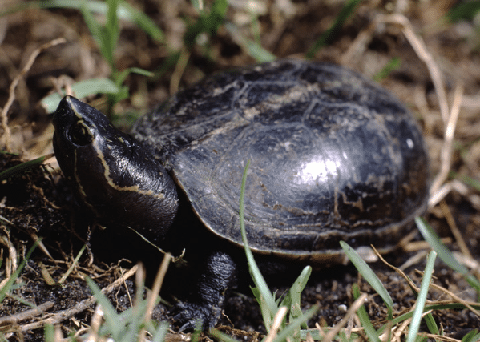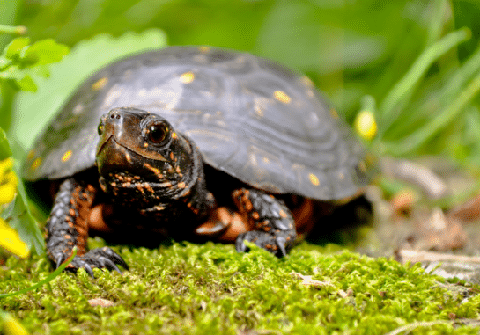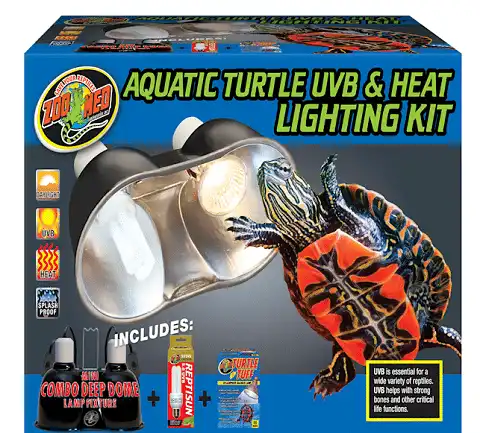Thank you for visiting! By the way… any links on this page that lead to products on Amazon and other stores/partners are affiliate links Aquarium Store Depot earns a commission if you make a purchase.
Fish are not the only wet pets that can live in aquariums. Freshwater turtles also make fascinating and long-lived companions if you can create the right habitat for their needs!
In this guide, I introduce 7 types of turtles for aquariums that you can keep and explain some important care requirements. I’ve also included a basic guide to turtle care, so make sure you read to the end for some helpful tips and information for beginners.
Let’s get started!
Key Takeaways
- There are many different types of freshwater turtles in the aquarium trade, and each has its own unique needs and preferences
- Captive-bred turtles can make fascinating pets, although they do not like to be touched or handled
- Aquariums can make excellent turtle habitats, although these amphibious reptiles require some dry land in their tank where they can bask
- Your turtle’s tank must include a basking platform or secure floating log where your pet can crawl out to warm up
- Turtles also need a special UV bulb if kept indoors. This essential requirement helps turtles make vitamin D and absorb calcium.
7 Best Turtles For Aquariums
Are you ready to meet some awesome aquatic and semi-aquatic turtle types? Let’s dive in and learn about seven great turtle species that you can keep in a home aquarium! We have a video just for you below from our YouTube Channel. Our blog also goes into more detail.
1. Red Ear Slider

- Scientific name: Trachemys scripta elegans
- Care level: Intermediate (Suitable for beginners)
- Temperament: Calm and friendly but does not enjoy being handled
- Minimum tank size: 50 gallons
- Potential lifespan: Up to 40 years in captivity
- Recommended temperatures: 70-85°F ambient, 85-90°F basking spot, 75-85°F water
The red-ear slider is the first species on my list because these colorful reptiles are one of the most popular and attractive pet turtle species in the world! These turtles are suitable for beginners, although they need regular care and water quality maintenance to stay healthy.
This species is easily available from pet stores, but you can often find mature specimens up for adoption too. These large and colorful reptiles are naturally beautiful, although albinos and various other awesome morphs are available from breeders.
Keeping these wonderful animals is a long-term commitment since they can live for over 30 years. Red-eared sliders can reach 12 inches when full-grown, so they need an enclosure of at least 50 gallons for long-term care.
2. Striped Mud

- Scientific name: Kinosternon baurii
- Care level: Intermediate
- Temperament: May scratch and bite, should not be handled
- Minimum tank size: 30 gallons
- Potential lifespan: Up to 50 years
- Recommended temperatures: 80-85°F ambient, 87-92°F basking spot, 75-80°F water
The striped mud turtle is a small species that grows a shell length of just 3.5-4.5 inches. Despite their size, these miniature creatures can live for half a century with good care!
These turtles are characterized by three pale stripes on their oval shell, although these markings may fade as the animal matures. They are omnivorous turtles that feed on invertebrates and plant material in the wild.
Striped mud turtles can be kept in a smaller tank than the red-eared slider, although they require good water quality, UVB bulbs, and a suitable basking area just like other species.
3. Spotted

- Scientific name: Clemmys guttata
- Care level: Intermediate
- Temperament: Alert and active but does not enjoy handling
- Minimum tank size: 30 gallons
- Potential lifespan: Up to 50 years
- Recommended temperatures: 80-85°F ambient, 95°F basking spot, 70-75°F water
The spotted turtle is an attractive North American species that grows to about 5 inches or so. These turtles are identified by their dark overall coloration and yellow spots on the head and upper shell.
Spotted turtles will eat some plant matter, although they are mostly carnivorous. Captive specimens will thrive on quality commercial pellets supplemented with meaty foods like worms and crickets.
These turtles are not the best swimmers, so keep their water shallow enough for them to breathe at the surface while standing and provide plenty of dry land where they can hang out and bask.
4. Maps

- Scientific name: Graptemys spp.
- Care level: Intermediate-advanced
- Temperament: Naturally active but shy around people
- Minimum tank size: Species dependent. Large species may require over 100 gallons
- Potential lifespan: Can live for over 30 years
- Recommended temperatures: 75-85°F ambient, 90-95°F basking spot, 70-80°F water
Map turtles are some of the most beautiful semi-aquatic turtles available in their pet trade. There are many species, and some have interesting patterns on their skin and shells and textured scales on their upper shells (carapaces) that make them excellent display animals.
However, map turtles require very clean living conditions and a varied diet. They are not recommended for beginners, although dedicated turtle keepers with moderate experience should have no problems.
5. Musk

- Scientific name: Sternotherus odoratus
- Care level: Intermediate
- Temperament: May scratch and bite. These turtles should not be handled
- Minimum tank size: 30 gallons
- Potential lifespan: May live for over 60 years
- Recommended temperatures: 83-86°F ambient, about 90°F basking spot, 72-78°F water
Common musk turtles (also known as stinkpots) get their name from the smelly odor they produce when frightened, although captive-bred pets are less likely to react this way once they get used to you.
These small aquatic turtles grow to about 4 inches and spend most of their time in the water. However, they require a dry basking spot just like the other species in this list.
Musk turtles are suitable for beginners and their small enclosure requirements make them a popular choice for people with limited space.
6. Diamondback Terrapins
- Scientific name: Malaclemys terrapin
- Care level: Intermediate
- Temperament: Generally peaceful but may bite if handled
- Minimum tank size: 55-75 gallons
- Potential lifespan: Up to 40 years
- Recommended temperatures: 80-85°F ambient, about 90°F basking spot, 75-78°F water
Diamondback terrapins are the only species on this list that aren’t naturally found in freshwater habitats. These colorful reptiles are at home in brackish water systems along the East and Gulf coasts of North America. While captive-bred specimens are often kept in freshwater, you will need to increase the salinity to create conditions that match their natural habitat.
This is a medium-sized species and females can reach a shell length of about 9 inches. In common with many other turtle species, the males are much smaller, maxing out at a shell length of about 5 inches.
Diamondback terrapins are carnivorous reptiles that feed on small animals like snails. However, captive specimens do well on commercially sold turtle foods like floating sticks.
7. Eastern Box Turtle
- Scientific name: Terrapene carolina carolina
- Care level: Advanced
- Temperament: Generally docile but males can be aggressive toward each other
- Minimum enclosure size: Approximately 15 square feet
- Potential lifespan: May live for over 50 years
- Temperature requirements: 65-75°F ambient, 80-90°F basking spot
Box turtles are unique land-dwelling reptiles with a high, dome-shaped shell that can be closed off with a special hinge on the lower shell (plastron). There are several species of box turtles in North America, although the Eastern box turtle is one of the more commonly available captive-bred pet species.
These colorful reptiles are not suitable for aquariums due to their mostly terrestrial nature, although they love soaking in water and they can swim and even submerge themselves. They should be kept in large outdoor enclosures, preferably planted with vegetation that will provide shade and shelter. However, they can also be kept in large indoor terrariums if you manage the temperature and provide UV lighting.
Before You Pick One
There are many different turtle species available in the hobby, so choosing the perfect species can be tough if you’re just getting started. Here are four quick tips for choosing your first turtle.
- A Long-term Commitment
Some turtles can live for over 50 years, and many of them outlive their owners. Many turtles that are bought as juveniles will outlive their first owners, so consider buying an adult or adopting a pet from someone who can no longer care for it.
- Insist on Captive-bred
Your turtle’s health should be your first priority, so choose healthy, captive-bred animals and never buy animals that were taken from the wild. I recommend choosing a species that is easily available and easy to care for.
- Turtle Tank Size
You’ll notice that each species has a different minimum tank size, although your turtle will definitely appreciate a larger habitat. Some turtles need very large enclosures when they reach adult size, so factor this in when choosing your pet.
- Plan Ahead
It’s important to consider your new turtle’s care requirements and create a suitable habitat before you bring it home – it will be a whole lot less stressful for you and your pet!
Care – The Basics
Enclosure size
Freshwater turtles can be kept in aquariums, large plastic containers, or even indoor ponds. The size of their habitat will depend on the size of the species, although your pet will appreciate plenty of room to explore. Small species like mud and musk turtles can be kept in enclosures as small as 30 gallons, while larger types may need enclosures of at least 5 feet long and wide. A 55 gallon tank is usually a good start for many of the turtles on this list.
The 55-gallon aquarium is a great budget-friendly larger tank. It often goes on sale at chain pet stores.
Basking Spot
Most freshwater turtles leave the water regularly to bask in the sun. They do this to warm their bodies and absorb Ultraviolet rays. A turtle tank must include a dry area where your pet can hang out above the water line.
A floating shelf above the water is a great option as it does not take up any swimming space. However, the shelf must be secured below your tank lighting and be sturdy enough for your pet to climb on and off. You can see that egg crate plastic and acrylic can work for a turtle ramp.
You can also use a large piece of driftwood or rocks to create a more natural look, although this can take up a lot of space in your turtle’s tank.
Layout
Fishkeepers enjoy creating beautiful underwater scenes in their aquariums, but experienced turtle keepers know to keep things simple. A tank without substrate, decorations, and plants is much easier to clean and maintain.
Care and Maintenance
Maintaining Water Quality
Turtles are surprisingly messy eaters and they produce plenty of waste. You will need good filtration to keep their habitat clean and maintain healthy water quality. Internal power filters and canister filters work well for turtles. Canister filters are usually preferred given the amount of waste a turtle can produce.
High flow, large filtration capacity, and quality plumbing - The FX series is designed for monster fish keepers
Neglected turtles in dirty water are prone to health problems, so regular maintenance is really important. Perform regular water changes in your turtle tank and give it a thorough cleaning from time to time to maintain hygienic conditions.
Lighting
Turtles kept indoors need access to ultraviolet light to grow healthy bones and shells and to prevent a serious health condition called metabolic bone disease. Without a special UVB light, turtles cannot produce vitamin D and absorb the calcium they need to stay healthy.
While natural sunlight provides UVA and UVB light, most artificial light sources do not. Purchase a special UV bulb designed specifically for turtles and other reptiles. The light source should be positioned above the basking spot and be run on a timer for ten or more hours each day.
This UVB kit from Zoo Med offers a good value and is perfect for new turtle keepers
Heating
Turtles are cold-blooded animals that require external heat sources to warm their bodies. Your UVB bulb may double as a heat lamp or you may need to install a separate basking lamp to create the perfect temperature.
The water in your turtle’s tank may need to be heated with a fish tank heater to maintain a comfortable temperature. Use a thermometer to monitor the temperature and create a safe and comfortable environment for your pet.
Diet
Turtles are easy to feed, although a varied diet is recommended to keep them happy and healthy. Provide a pellet/stick food made for turtles and supplement it with some fresh foods like romaine lettuce, crickets, and mealworms.
Most species are omnivores that feed on insects and soft plant material, although different species have different diets. Be sure to research the needs of your pet to create a healthy meal plan.
Feeding
Overfeeding can cause health problems so fight the temptation to provide too many snacks! Young turtles can be fed every day while adult specimens should do well with a meal every other day.
Some turtle keepers move their pets to a separate container at feeding time so they can simply discard the dirty water and uneaten food to keep their main enclosure cleaner for longer. However, this is not recommended for new pets that are still adapting to their new home as unnecessary handling can be stressful.
Veterinary Care
Turtles are exotic pets that may need the care of specialist veterinarians. It’s a good idea to contact an exotic pet veterinarian in your area if your pet requires medical care.
What kind of turtle can live in a fish tank?
Some aquatic turtles can live with fish, although it is risky to keep them together because turtles will snack on fish and other small animals. Turtles also have different habitat requirements to fish, so it’s better to keep these reptiles in an enclosure designed specifically for their needs.
Is it OK to put a turtle in an aquarium?
Many aquatic turtles can be kept in glass aquariums, although they have some special requirements. Their aquarium must include a basking platform where they can crawl out of the water and a special UV light bulb to keep them healthy.
You should never take a turtle from the wild and keep it as a pet. Many species are now endangered in the wild, and captive-bred specimens tend to be much healthier and easier to care for anyway.
Can turtles live in a tank full of water?
Some aquatic turtles can be kept in a tank full of water, although some semi-aquatic turtles need shallow water so that they can keep their head above the surface. Almost all species will require a dry basking spot where they can climb out of the water and heat up.
Terrestrial turtles and tortoises should not be kept in water!
What is the easiest turtle to care for?
Musk and mud turtles are relatively easy to care for because they stay small and do not require a very large habitat. However, the larger red-eared slider is hardy and easy to care for if you have the space.
How big of a tank do I need for 2 turtles?
The minimum tank size for two turtles will depend on their age and species. You can keep a pair of small turtles in a tank of about 50 gallons, although larger animals will require more space.
Final Thoughts
Keeping turtles is great for people of all ages and each of the aquatic turtles in this guide make great pets if given a good home and properly cared for. I hope the information in this article has helped you choose your new friend for life and given you some insight into the basics of aquatic turtle care and husbandry.
My final advice for new turtle owners is to factor in their impressive lifespan, especially when buying a juvenile specimen. It’s also important to research the specific needs of the species you choose so that you can provide a happy home for your new companion!
Do you have an aquatic turtle tank? Tell us about your favorite species in the comments below!
- About the Author
- Latest Posts
I’m thrilled that you found Aquarium Store Depot! Here you’ll find information on fish, aquariums, and all things aquatics related. I’m a hobbyist (being doing this since I was 11) and here to help other hobbyists thrive with their aquariums! I adhere to a high quality Editorial Process and Review products with real life field usage and practical analysis.








